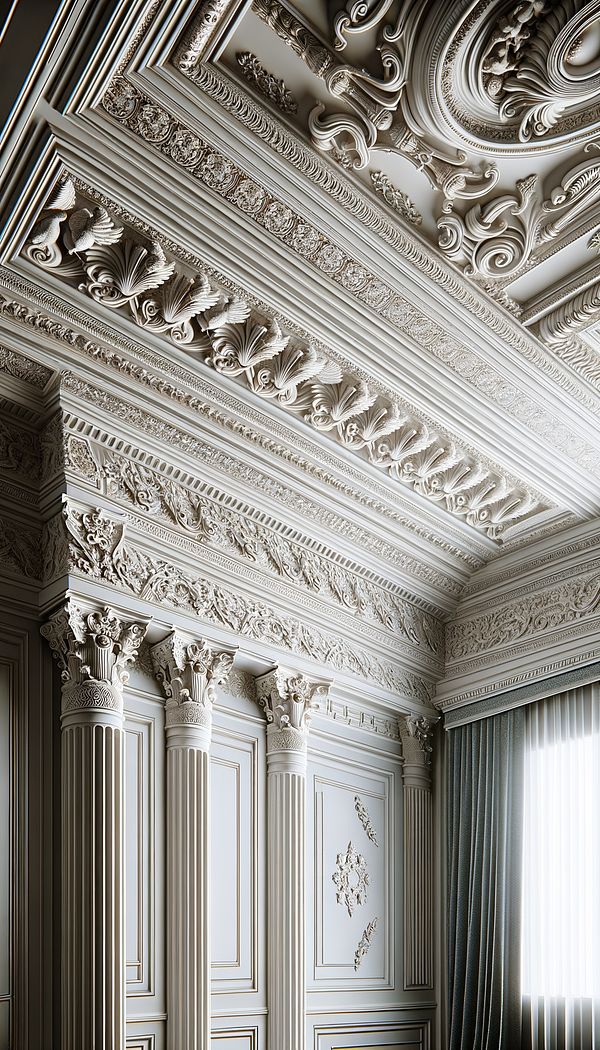What is Frieze?
Frieze refers to a wide, decorative band, typically found near the ceiling on walls, or on the exterior of buildings.
Description
In the realm of interior design, 'frieze' is a term that carries both decorative and architectural weight. Traditionally, a frieze is a horizontal band, often adorned with sculpture, reliefs, or intricate designs, positioned near the ceiling of a room or on the exterior of a building. The frieze's history is deeply rooted in classical architecture, where it formed a vital part of the entablature in Greek and Roman buildings. However, its use and interpretation have evolved over centuries, enabling it to integrate seamlessly with various design styles ranging from classical to contemporary.
The frieze serves not only as an ornamental element but also plays a significant role in the cohesive appearance of a space. In interior settings, it can be a focal point, drawing the eye upwards and accentuating the height of a room. Moreover, a frieze can incorporate various materials, including plaster, wood, or even modern materials like polymers, demonstrating its versatility in decorative techniques. It might showcase intricate patterns, scenes from mythology or history, or abstract motifs, depending on the design intent.
In contemporary practice, the concept of a frieze has been adapted beyond its classical origins. Designers might use it as a thematic link between different areas of a building or as an innovative way to integrate textiles and upholstery or wall treatments and finishes into a space. This adaptability highlights the frieze's enduring appeal and utility in creative interior design. Whether in historic restorations or modern interpretations, the frieze remains a significant and versatile design element.
Usage
Friezes are commonly found in classical architecture, including temples, public buildings, and high-status homes. In modern interior design, friezes may be seen in elaborate hotel lobbies, luxury residences, and refined dining establishments, where they add a layer of elegance and historical reference. Additionally, contemporary designers sometimes use friezes as a decorative element in less traditional settings, such as minimalist homes or avant-garde spaces, by selecting modern materials and patterns that complement the overall design theme.
FAQs
-
Can a frieze be used in any style of interior design?
Yes, while traditionally associated with classical styles, friezes can be adapted to fit various interior design styles, including modern and contemporary settings, by modifying materials, patterns, and scale.
-
Are friezes only used for decorative purposes?
Primarily, friezes serve an ornamental function, but they can also contribute to the thematic cohesion of a space and highlight architectural features such as the ceiling height.
-
What materials are typically used to create a frieze?
Friezes can be made from a variety of materials, including plaster, wood, stone, and modern polymers, allowing flexibility in design and application.
Practical Application
When incorporating a frieze into your design, consider the scale and style of the room to ensure it enhances rather than overwhelms the space. Select materials and designs that complement the overall aesthetic of the room, and use lighting to accentuate the intricate details of the frieze, making it a standout feature.
-
Architectural Elements199 articles
-
Design Styles478 articles
-
Decorative Techniques322 articles
-
Wall Treatments & Finishes157 articles
-
BaggingBagging is a decorative wall finish obtained by applying a thin cement-based layer to walls and then manipulating it with a sponge or cloth.
-
Construction DrawingsConstruction drawings are detailed plans and drawings produced by architects and designers to guide the construction or renovation of a building.
-
ArmoireAn armoire is a versatile, freestanding wardrobe or closet.
-
ChecksChecks refer to a pattern comprising of crisscrossed horizontal and vertical lines, forming squares.
-
StuccoStucco is a type of plaster used as a coating for walls and ceilings.
